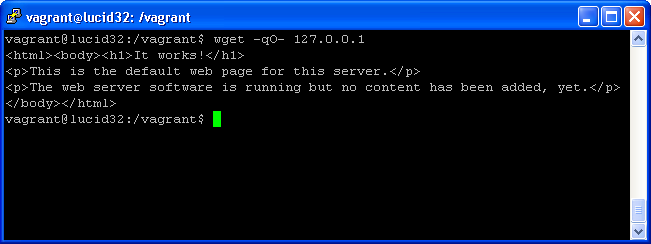vagrant 入门3
2016-01-11 00:18
295 查看
创建第一个Vagrant虚拟环境以及工程(续集):
(8) Provisioning:通常情况下Box只做最基本的设置,而不是一次到位的设置好所有的环境。Vagrant通常使用chef或者Puppet来做进一步的环境搭建。
回到刚才创建的index.html,我们需要安装Apache。我们下面用Puppet来完成这一设置。
1. 在项目的根目录下创建文件夹manifests,然后在该文件家中创建Puppet的配置文件default.pp,该文件内容如下:
# Basic Puppet Apache manifest
class apache {exec { 'apt-get update':command => '/usr/bin/apt-get update'
}
package { "apache2":ensure => present,
}
service { "apache2":ensure => running,
require => Package["apache2"],
}
}
include apache
[/code] 2. 在Vagrantfile里添加对Puppet provisioning的支持:
Vagrant::Config.rundo|config|
config.vm.box="base"
# Enable the Puppet provisioner
config.vm.provision:puppet
end
[/code](9) 运行Project
为了使puppet的配置生效,如果不重启虚机,则需要执行vagrant reload命令。
$ vagrant reload
[/code] 因为没有配置port forwarding,所以你还不能从本地浏览器查看Project的输出。只能SSH到虚拟机上查看127.0.0.1的输出:
 |
修改Vagrantfile, 添加本地端口和虚机端口的映射关系, 然后执行vagrant reload, 然后你就可以通过本地浏览器来访问:http://localhost:4567.
Vagrant::Config.run do |config|
# Forward guest port 80 to host port 4567
config.vm.forward_port 80, 4567
end
[/code]
 |
相关文章推荐
- Eclipse 编译StanfordNLP
- 夏泽网 中国渔业统计年鉴年鉴资料网
- Exception in thread main java.lang.UnsopportedClassVersionError解决办法
- vagrant 入门4
- Stanford CoreNLP开源项目的3种编译和运行方式[2]
- div层调整z-index属性无效原因分析及解决方法
- vimium 基本使用快捷键
- 123
- ORACLE数据库测试数据插入速度
- vagrant 入门2
- ASP.Net学习笔记003--网站和WebApplication的区别
- 用直接路径(direct-path)insert提升性能的两种方法
- 小学生之Oracle分析函数
- Python中的闭包实例详解
- SAP R3 FI 上线 顾问设置教程(一)
- JWT中的一些错误
- ASP.Net学习笔记002--ASP.Net服务端控件做了什么2
- [java]Enum在switch中的比较判别
- 软工总结博客
- 用C语言打印杨辉三角
